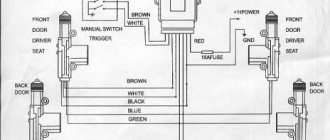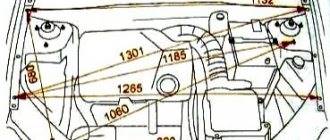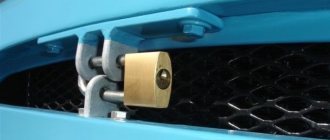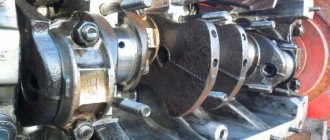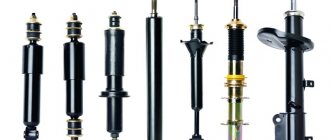Engineers designing cars came to the conclusion that it was necessary to use special holes to direct the air flow quite quickly. An internal combustion engine requires a significant amount of air, and the higher the efficiency, the more air it needs. To understand the reason for this phenomenon, we should remember that the engine runs not just on fuel poured into the tank, but on a fuel-air mixture.
The source of energy is a chemical reaction that is reproduced in the engine cylinders during the combustion of the fuel-air mixture. When this reaction occurs, molecular bonds are destroyed, and this is accompanied by the release of thermal energy in huge quantities. The engine uses this energy - it converts it into mechanical energy in the form of rotation of the crankshaft. From this we can draw the following conclusion:
- To operate, the vehicle requires constant air supply in very large quantities.
- During operation, the engine heats up to very high temperatures, thereby heating the engine compartment around it.
Main purpose
Considering the conclusions drawn, we can say that the air intake on the hood is designed to significantly help the engine in its operation. It will help both cool the engine compartment and refresh the air before mixing it with fuel.
As you already know, the engine needs air to operate. But, to clarify, it is not so much the air itself that is needed, but pure oxygen. The car air filter helps clean the air from all impurities.
However, in the summer, or in countries with hot climates, already heated oxygen gets under the hood where it becomes even hotter from the running engine. This fact has an extremely negative effect on the power performance of the engine, since hot air contains less oxygen.
Gills on the hood, if installed correctly, will help create a directed stream towards the air filter opening. Then the air entering from the atmosphere will not have time to heat up and will immediately be supplied to the working space of the engine. Another advantage of this solution is that the amount of captured air will increase and, as a result, the oxygen level in the engine working mixture will rise slightly.
What does the air intake on the hood do?
Everyone knows that an engine consumes not only fuel, but also air. But, in fact, what is important for an engine is not so much the air itself, but the oxygen that is part of the air. It is oxygen that promotes fuel combustion. And the amount of oxygen in the air depends on temperature. In the engine compartment, the air temperature is naturally high. Hence the low oxygen content. Although it is quite enough to keep the engine running smoothly.
But if you provide additional air flow from the outside, it becomes easier for the engine to “breathe”, ensuring more complete combustion of fuel inside the cylinders, which can ultimately lead to a certain increase in the car’s power.
It should be said right away that you can feel the increase in power, although small, only at high engine speeds. When the air supplied according to the usual pattern is no longer enough. Thus, the air intake, due to its shape, provides additional air entry into the engine compartment, making this air colder and, accordingly, more oxygen-containing.
If we consider the function of tuning or car design, then, of course, the air intake changes the appearance of not only the hood, but the entire car. How much it fits into the overall silhouette of the car is always a matter of taste of the car owner. But it’s a fact that the car looks different with the air intake.
Where can the air intake be installed on the hood?
It is important to install the hood intake so that the air flow reaches the air filter with maximum efficiency. Only in this case will the effect be noticeable, at least at high engine speeds.
To do this, not only the air intake itself is used, but also various pipes that additionally direct the air flow. The fact is that sometimes the air filter is not located exactly in the middle of the hood, but somewhere on the side.
In this case, either a long air intake structure can be used, which blows through the entire engine compartment, or a system of two symmetrically installed air intakes located at the edges of the hood can be used. Those. it will turn out that one air intake will accurately direct the flow to the filter, and the second will indirectly perform this function.
Although on some cars intended purely for sports, the air intake can be installed on the side without any symmetry. And here only the functionality of the air intake is considered, and not the external beauty of this element.
Materials for the production of air intakes
The predominant number of these elements of car body kit are made of durable plastic. There are plenty of different models that can be selected for any car.
In addition, air intakes can be made of the same metal from which the car hood is made. In this case, U-shaped slots are made in the hood, and the metal of the hood is bent at a certain angle to form the air intake profile. Then triangular pieces of metal are welded along the edges, which cover the ends of the air intake. Then everything is puttied and painted.
It is important, when the air intake is made according to this design, not to cut the stiffeners that are in the hood structure. Otherwise, the rigidity of the hood will change dramatically. Naturally, with this method of creating an air intake, the hood must be dismantled before all operations.
Another material used to make air intakes is fiberglass. Usually, a blank mold is first made from polyurethane foam or plaster. Then the form is covered with fiberglass using epoxy resin. It is important here that before you start gluing the form, cover it with parquet mastic so that the epoxy glue does not stick to the form.
After this, apply fiberglass layer by layer, soaking everything with epoxy glue. After everything has hardened, the surface is sanded, puttied and painted. Only after this the part is installed in the hole on the hood.
Most often, the air intake is attached to the hood using silicone sealant. Although there may be options when fastening is done from the inside of the hood using self-tapping screws. It all depends on the shape of the air intake. In industrial structures, mounting elements may also be included in the kit. But when purchasing or designing an air intake, it is always important to take into account the location of the stiffeners on the hood.
Some air intakes on the hood are additionally equipped with intercoolers to direct the flow to the right place and create even colder air.
Motor cooling
It is also worth noting that airflow plays a significant role in cooling the engine itself. A hood scoop that has been thoughtfully installed can help cool engines that are mounted longitudinally under the hood. A very good example is the Niva 21214 car. Using this car off-road using a low gear leads to significant temperatures under the hood, and the slow movement of the car cannot provide sufficient oxygen supply.
The air intake on the hood is something that can significantly make life easier for the Niva engine and even extend its service life.
The system that was developed for rally cars is very interesting. As you know, in ordinary cars the air enters the engine compartment through the radiator grille cold and then heats up. The proposed technology includes an air intake on the hood and a special device that sucks hot oxygen from the cavity above the engine, thereby making room for fresh and cold oxygen. The use of such a system is rational for cars whose engines are used for long, non-stop journeys.
Reasons for decreased performance
In addition to obvious malfunctions due to which the stove does not work or functions incorrectly, there are other problems with the heating system of the VAZ-2107 interior. The main one is a decrease in stove performance.
If the stove heats poorly, then the reason lies in:
- Malfunctions of the power plant cooling system (reduced pump performance, stuck thermostat).
- Radiator clogged.
- Formation of an air lock in the heater radiator.
- The air intake damper seal is worn out.
To find the cause of decreased performance, start by checking the heating of the heater radiator. To do this, heat the engine to operating temperature, fully open the antifreeze supply valve to the stove and hand check the degree of heating of the supply pipe before and after the valve and the radiator itself. If the pipeline is hot before the tap, but not after it, the tap is jammed. If the radiator does not warm up, the reason lies in severe clogging of the heat exchanger or a plug in it. If the pipeline does not warm up even to the tap, inspect the cooling system.
If the radiator warms up well, but it is noted that the stove heats worse, then check the functionality of the air intake damper and the condition of its seal. It wouldn’t hurt to check the stove body and air ducts for leaks and cracks.
To ensure that the VAZ-2107 heater heats well, before the winter period check the functionality of the tap, replace the antifreeze (with flushing the system), inspect the control mechanism and the functionality of the dampers.
Ventilation, heating and air conditioning of the interior
| GENERAL INFORMATION |
Ventilation and heating
To regulate the air temperature, a system of mixing cold and hot air is used. This system provides low-inertia regulation of air temperature, which is practically independent of the vehicle speed. The intensity of air supply into the cabin is determined by the fan rotation speed. Therefore, if necessary, the fan should be turned on even when the car is moving. To heat the footwell area of the rear seat passengers, warm air is supplied through air ducts located under the carpet.
Air can enter the cabin through both central vents. The degree of air supply is adjusted depending on the position of the air supply regulator located between the grilles. The direction of air flow from the central deflectors can be adjusted as desired in both horizontal and vertical planes using levers that tilt and rotate the deflectors.
Air can enter the vehicle interior through the left and right side vents.
Nozzles for blowing the side windows of the front doors
Cold or warm air flows onto both the windshield and side windows of the front doors (mainly into the areas that provide visibility to the outside rear-view mirrors).
Cabin air conditioning system
Ventilation, heating and air conditioning systems are a single functional complex designed to provide the most comfortable conditions in the car in any season of the year, regardless of weather conditions and ambient temperature. The cooling unit of the air conditioning system reduces the temperature and humidity of the air, as well as filters it from dust. The heating system heating unit provides an increase in air temperature in any operating mode, depending on the position of the temperature regulator. The amount of air entering the cabin depends on the operating mode of the fan.
Start the engine, use the switch to set the required fan operating mode and press the air conditioning button. When the air conditioner is turned on, the control lamp will light up. To turn off the air conditioner, press the same button again.
Please note that the air conditioner will not turn on if the fan mode switch is in the OFF position or the ambient temperature is below 0° C. Warning
If the air conditioning system operates while the vehicle is driving on long hills or in heavy city traffic, monitor the engine temperature. Operating the air conditioner in this case may cause the engine to overheat. If the coolant temperature exceeds the permissible value, turn off the air conditioning system.
Air temperature regulator
The regulator provides a smooth change over a wide range in the temperature of the air entering the vehicle interior. In this case, outside air can be heated, cooled or directed into the cabin without changing the temperature. Moving the control knob to the left increases the flow of cooled air (blue zone). Moving the regulator handle to the right increases the flow of heated air (red zone).
Air intake on a motor with a turbine
From an aesthetic point of view, simply installing an air intake on the hood brings the car's appearance closer to a sporty one, but does not have any technical improvements. So before installation, you should think 100 times whether it’s worth cutting the hood for this. However, when building a sports engine with a turbocharger, the use of an air intake is very desirable. But you should think about installing an intercooler. The intercooler is designed to cool the air before it enters the boost.
If you install gills on the hood and a horizontal intercooler, then the air passing through them will qualitatively cool the air inside the cooler and significantly increase the boost efficiency.
The only inconvenience that embedded gills on the hood can create is the constant entry of dust and all sorts of debris into the engine compartment, but otherwise there are only advantages.
We make an air intake for a VAZ 2107
Do you want to give your car some respectability, but don’t know where to start? You will have to work hard for this or take the car to a car service center, they will do everything for you, although at the end of the work they will present you with a bill, which will not make you feel very good. Let's say that you decide to do the tuning yourself, with your own hands.
We are making an air intake for a VAZ 2107. First, find a small piece of foam plastic, it can be found in boxes from household appliances, for example, from a refrigerator. Take a well-sharpened knife and cut out the model, which will later become the air intake on the VAZ 2107. After you have cut it out, treat it with foam. Then you start sanding to make something similar from a piece of foam plastic to the part you are going to install. It’s good if you have an image of the air intake, according to which you will make it. Do everything carefully, slowly, because if you make a mistake in the calculations, you will have to start the work all over again; the part at this stage is very fragile. In this state it will not be possible to put it on the hood; it needs to be stiffened. To achieve this, we treat the foam with epoxy glue and a bandage.
There is nothing complicated to do, first a layer of epoxy glue is applied to the part, there is no need to spare it, the more the better, then the whole thing is wrapped with a medical bandage, after which we apply an additional layer of glue and wrap it with a bandage again. This can be done several times, but the last layer should be adhesive. Let the air intake dry. How long this will take depends on the glue you use. Now you have a rigid, durable part that you can’t easily break. Next we will need two types of putty: with fibers and finishing. Working with putty with fibers is quite difficult and requires patience and skill. We wait until it dries and sand it. We work with finishing putty, then the part is ready for painting. After the work is done, the part looks like iron. Let's start painting the air intake. The first layer should be black to give depth. Then paint it the color you choose. Don't forget to wait for the first layer to dry. Do not allow dust to enter the undried air intake, otherwise there will be a feeling of roughness. All that remains is to install it in place. Double-sided tape is useful for this; it can be found at any hardware store. For better adhesion, add sealant. It may get on the edges, so be sure to wipe it off.
- Author: Soulless Robot
Rate this article: Share with friends!
Related posts:
We make eyelashes for VAZ 2107 headlights with our own hands
DIY air intake for VAZ 2110
Plastic hood of VAZ 2108. We make a matrix.
